Canada's housing market continues to slow
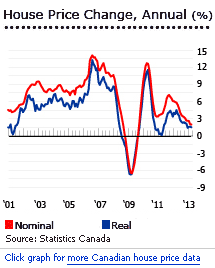
The pace of house price rises in Canada has slowed sharply, due to several rounds of government market-cooling measures, and the slowing economy. House prices in Canada’s eleven major cities rose by 2% during the year to May 2013 (1.5% inflation-adjusted), the lowest year-on-year increase since October 2009, based on figures from Teranet – National Bank of Canada.
- The average price of single family homes rose by 2.8%
- The average price of townhouses/row units increased 1.9%
- The average apartment price rose by 1.1%
Of Canada’s eleven major cities, nine saw house prices rise during the year to end-May 2013.
Quebec registered the highest house price increase of 6.5% (6% inflation-adjusted), followed by Calgary (5.8%) and Hamilton (5.8%). House prices also increased in Winnipeg (4.6%), Edmonton (4%), Toronto (3.9%), Halifax (2.3%), Ottawa (2%), and Montreal (1.9%).
In Vancouver, the capital, house prices dropped 3.2% (-3.7% inflation-adjusted) during the year to May 2013. House prices in Victoria also fell by 4.1% (-4.5% inflation-adjusted) over the same period.
The aggregate composite MLS® house price index rose by 2.3% y-o-y in May 2013, according to the Canadian Real Estate Association (CREA).
The national average price for homes sold increased to CA$388,910 (US$381,434) in April 2013 from a year ago, according to CREA.
From Q1 2000 to Q1 2009 house prices in Canada rose 79% (49% inflation-adjusted), mainly due to low interest rates and continuous economic growth. House prices increased by another 24% (17% inflation-adjusted) from Q2 2009 to Q3 2012, despite efforts by the government to cool the housing market.
Although several property market analysts have predicted a crash, the government maintains its positive outlook on the Canadian housing market. “When I look at the housing market, I’m looking for the ‘doom and gloom’. I don’t see the ‘doom and gloom’. I see some moderation in demand. This is a good thing,” said Canadian Finance Minister Jim Flaherty.
“Canadians remain confident about the value of home ownership,” said CREA chief economist Gregory Klump. “Job market trends and low interest rates remain supportive for Canada’s housing sector, so we remain upbeat about prospects for sales and average prices this year and next,” Klump added.
Canada’s economic growth is projected to slow to 1.5% in 2013, down from real GDP growth rates of 1.8% in 2012, 2.6% in 2011 and 3.2% in 2010, according to the Bank of Canada (BoC), amidst weak exports and high domestic household indebtedness.
The BoC kept its key interest rate steady at 1% in May 2013.
Tighter mortgage lending rules
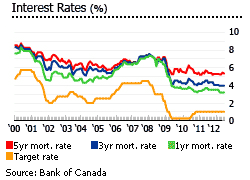
The dear that Canadian housing might be in bubble has been a major concern for the government. In order to ensure a soft landing, tighter mortgage rules take effect on July 9, 2012:
- The reduction of maximum amortization from 30 years to 25 years, discouraging buyers from acquiring too much debt; and
- Maximum LTV ratio was lowered from 85% to 80%.
As the Canadian Mortgage Trends (CMT) reports, the government will also:
- Limit the maximum gross debt service (GDS) to 39%, and the total debt service (TDS) to 44%; and
- Ban mortgage insurance on properties over $1 million.
These measures were applauded by Bank of Canada (BoC) Governor Mark Carney as appropriate and timely, a contribution to reducing household indebtedness. The new mortgage rules are expected to tighten mortgage lending, which the country’s low interest rates won’t.
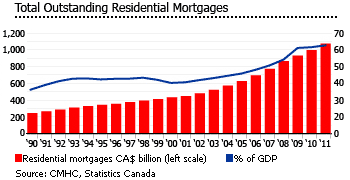
The Bank of Canada has maintained its key interest rate at 1% for 14 policy announcements, since implementation in September 2010.
Actual mortgage rates also remain at historic lows, compared to pre-crisis levels of 2008:
- The 1-year mortgage rate has fallen to 3.2% in May 2012, from 6.15% in May 2008.
- Interest rates on 3-year mortgages have decreased to 3.95% in May 2012, from 6.15% in the previous four years.
- The 5-year mortgage rate has fallen to 5.34% in May 2012, from 6.65% four years earlier.
Higher existing home sales in 2012
Sales of existing homes in Canada are expected to increase by 3.4% in 2012, to 472,300 units, according to the Canadian Mortgage and Housing Corporation (CMHC).
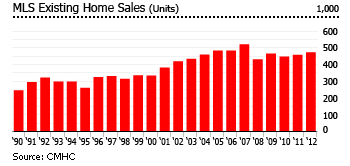
In 2011, rhere was a 2.4% increase in total MLS existing home sales. Leading the increase were Saskatchewan (10.3%) and Alberta (8.1%). Sales of existing homes in Canada peaked in 2007, when 520,511 housing units were sold.
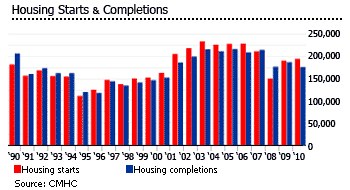
Housing starts slightly increased in 2011, by 2.1% to 193,950 units, having peaked in 2007 at 228,343 housing units. Meanwhile, completions fell by 6.01% in 2011, to 175,623 units. The average number of housing units completed from 2002 to 2008 was 207,244 units per year.
New house prices up a little
Canada’s new housing price index (NHPI) rose by 2.5% during the year to April 2012, according to Statistics Canada. The metropolitan areas with the highest y-o-y price increases were Toronto and Oshawa (5.9%), Regina (5.6%) and Winnipeg (4.3%).
Stable rental market; lower vacancy rate
Average rents in Canada increased 2.1% during the year to April 2012, according to CMHC. Rents for new and existing two-bedroom apartments rose in all provinces, with rises from 0.9% (Quebec) to as high as 6.6% (Manitoba).
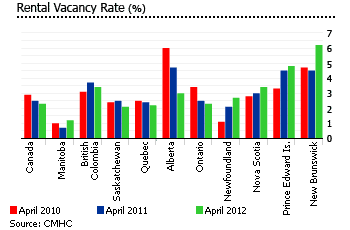
The most expensive rental properties can be found in Alberta, which has average monthly rents of CA$1,055 (US$1,028) for a two-bedroom apartment, followed by British Columbia with CA$1,036 (US$1,010) per month, and Ontario with CA$1,014 (US$988) per month.
Quebec offers the lowest rents for two-bedroom apartments at CA$677 (US$660).
Rental yields in Montreal are really attractive, ranging from 6.30% to 8.19% on small apartments, according to Global Property Guide research of January 2012. The average rental yield in Montreal increased to 7.19%, from its 6.06% average in 2011.
Toronto’s rental yields are lower, ranging from 3.68% to 5.59%. Its average rental yield fell to 4.70%, from an average of 5.71% in 2011.
Due to the country’s improving job market, and the influx of new migrants to major centres, demand for rental apartments has been increasing, causing a decline in the national vacancy rate to 2.3% in April 2012, down from 2.5% from a year earlier, according to CMHC.
Among the provinces, New Brunswick had the highest vacancy rate at 6.2%, followed by Prince Edward Island (4.8%), and Nova Scotia and British Columbia (3.4%). Manitoba had the lowest vacancy rate at 1.2%.
Economic slowdown

In the first quarter of 2013, Canada’s real GDP grew by an annualized rate of 2.5%, the fastest pace in six quarters, mainly driven by an increase in export revenues, according to Statistics Canada. Economic growth is expected to slow to 1.5% in 2013, amidst weak exports and high domestic household indebtedness. The Canadian economy expanded by 1.8% in 2012, a slowdown from GDP growth rates of 2.6% in 2011, and 3.2% in 2012, according to the Bank of Canada (BoC).
Unemployment fell to 7.1% in May 2013, down from an average of 7.8% between 2009 and 2012. There were about 95,000 new jobs created in May 2013, one of the biggest monthly gains in history, as companies and firms resumed hiring again after a four-month winter hibernation, according to Statistics Canada. Most provinces saw a decline in their jobless rates. Ontario registered the highest rise in employment with about 50,600 new jobs, following by Quebec (20,100 new jobs) and Alberta (18,600 new jobs).
In April 2013, the country’s overall annual inflation rate fell sharply to 0.4%, the lowest level since October 2009, mainly due to a drop in gasoline prices, according to Statistics Canada. This is well below market expectations, and well outside the Bank of Canada’s target range of 1% to 3%.
In its May 29th meeting (the last one under central bank governor Mark Carney), the BoC kept its key interest rate steady at 1%, as it has done for the last two-and-a-half years.
New BoC governor Stephen Poloz has signalled that there will be no significant shift in the currently accommodative monetary policy under his leadership, at least in the short run.